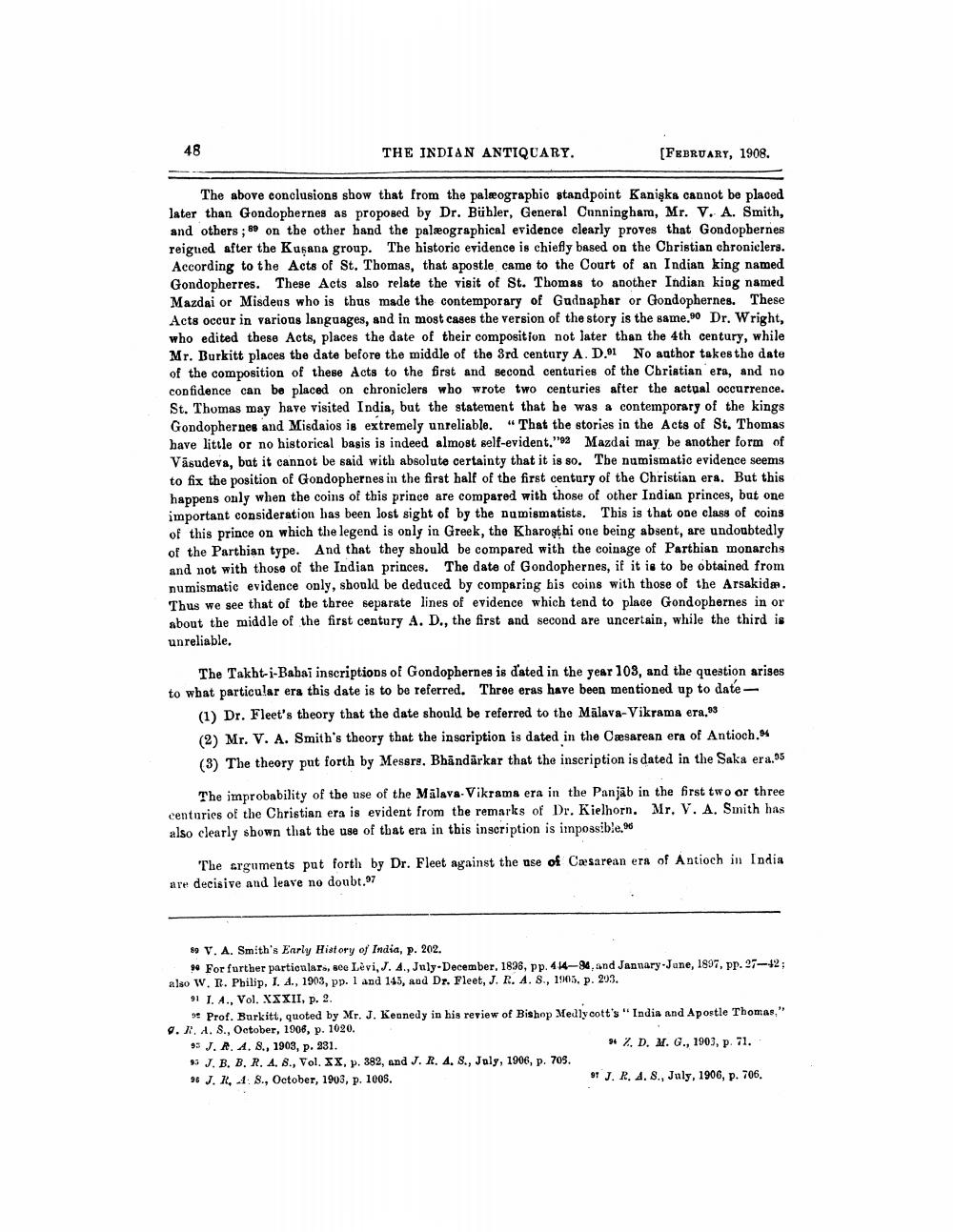________________
48
THE INDIAN ANTIQUARY.
[FEBRUARY, 1908.
The above conclusions show that from the palæographic standpoint Kanişka cannot be placed later than Gondophernes as proposed by Dr. Bübler, General Cunningham, Mr. V. A. Smith, and others; 89 on the other hand the palæographical evidence clearly proves that Gondophernes reigned after the Kusana group. The historic evidence is chiefly based on the Christian chroniclers. According to the Acts of St. Thomas, that apostle came to the Court of an Indian king named Gondopherres. These Acts also relate the visit of St. Thomas to another Indian king named Mazdai or Misdens who is thus made the contemporary of Gadnaphar or Gondophernes. These Acts occur in various languages, and in most cases the version of the story is the same.90 Dr. Wright, who edited these Acts, places the date of their composition not later than the 4th century, while Mr. Burkitt places the date before the middle of the 3rd century A. D.91 No author takes the date of the composition of these Acts to the first and second centuries of the Christian era, and no confidence can be placed on chroniclers who wrote two centuries after the actual occurrence. St. Thomas may have visited India, but the statement that he was a contemporary of the kings Gondophernes and Misdaios is extremely unreliable. "That the stories in the Acts of St. Thomas have little or no historical basis is indeed almost self-evident."92 Mazdai may be another form of Vasudeva, bat it cannot be said with absolute certainty that it is so. The numismatic evidence seems to fix the position of Gondophernes in the first half of the first century of the Christian era. But this happens only when the coins of this prince are compared with those of other Indian princes, but one important consideration has been lost sight of by the numismatists. This is that one class of coins of this prince on which the legend is only in Greek, the Kharoşthi one being absent, are undoubtedly of the Parthian type. And that they should be compared with the coinage of Parthian monarchs and not with those of the Indian princes. The date of Gondophernes, if it is to be obtained from numismatic evidence only, should be deduced by comparing bis coins with those of the Arsakida. Thus we see that of the three separate lines of evidence which tend to place Gondophernes in or about the middle of the first century A. D., the first and second are uncertain, while the third is unreliable.
The Takht-i-Babai inscriptions of Gondophernes is d'ated in the year 103, and the question arises to what particular era this date is to be referred. Three eras have been mentioned up to date -
(1) Dr. Fleet's theory that the date should be referred to the Mälava-Vikrama era. (2) Mr. V. A. Smith's theory that the inscription is dated in the Cæsarean era of Antioch.% (3) The theory put forth by Messrs. Bhandarkar that the inscription is dated in the Saka era.95
The improbability of the use of the Mälava-Vikrama era in the Panjäb in the first two or three centuries of the Christian era is evident from the remarks of Dr. Kielhorn, Mr. V. A. Smith has also clearly shown that the use of that era in this inscription is impossible.
The arguments put forth by Dr. Fleet against the use of Cæsarean era of Antioch in India are decisive and leave no doubt.97
89 V. A. Smith's Early History of India, p. 202.
9. For further partioulars, see Levi, J. A., July-December, 1898, pp. 414-94, and Jannary Jane, 1807, PP. 27-2; also W. R. Philip. I. A., 1903, pp. 1 and 145, Aud Dr. Fleet, J. R. 4. 8., 1905, p. 203.
91 1. A., Vol. XXXII, p. 2.
e Prof. Burkitt, quoted by Mr. J. Kennedy in his review of Bishop Medly cott's "India and Apostle Thomas," 9.1. 2, S., October, 1906, p. 1020. 95 J.A.A. 8., 1903, p. 331.
* Z, D. M. G., 1903, p. 71. 9 J. B. BR. 4. B., Vol. XX, p. 382, and J. R. 4. 8., July, 1906, p. 705. 95 J. R, 18., October, 1903, p. 1005.
9 J. R. 4. 8., July, 1906, p. 706.




